Physical Address
304 North Cardinal St.
Dorchester Center, MA 02124
Smooth muscle neoplasms are categorized by their site of origin; smooth muscle tumors with similar histologic features in different sites vary in terms of their prevalence, clinical behavior, and diagnostic criteria for malignancy. For example, benign smooth muscle tumors (leiomyoma) are common in the uterus, but are rare in the deep soft tissue.
Most smooth muscle tumors arise in association with pre-existing smooth muscle (e.g., pilar, uterine, and vascular smooth muscle tumors). In addition, smooth muscle tumors are one of the rare mesenchymal neoplasms that can be associated with an infectious agent: Epstein-Barr virus (EBV) in immunocompromised patients.
This chapter will focus on smooth muscle tumors arising primarily from the soft tissue. Uterine, genital, and visceral smooth muscle tumors are not described in this book and are instead discussed in other editions of this series.
Leiomyomas are composed of well-differentiated smooth muscle cells and are classified by their site of origin, including the retroperitoneum, skin, or visceral sites. They tend to be circumscribed though not encapsulated. On cut section, they usually have a firm, whorled surface that ranges from white to gray. Microscopically, they are composed of relatively uniform spindled cells in intersecting fascicles, with cells often arranged parallel and perpendicular to the plane of section. Cells show eosinophilic cytoplasm and blunt-ended, so-called “cigar-shaped” nuclei ( Fig. 6.1 ). Cytoplasmic vacuolation and a perinuclear clear zone may be seen. Familiarizing oneself with this histologic appearance is important, since well-differentiated smooth muscle tumors demonstrate this morphology regardless of the site of origin.
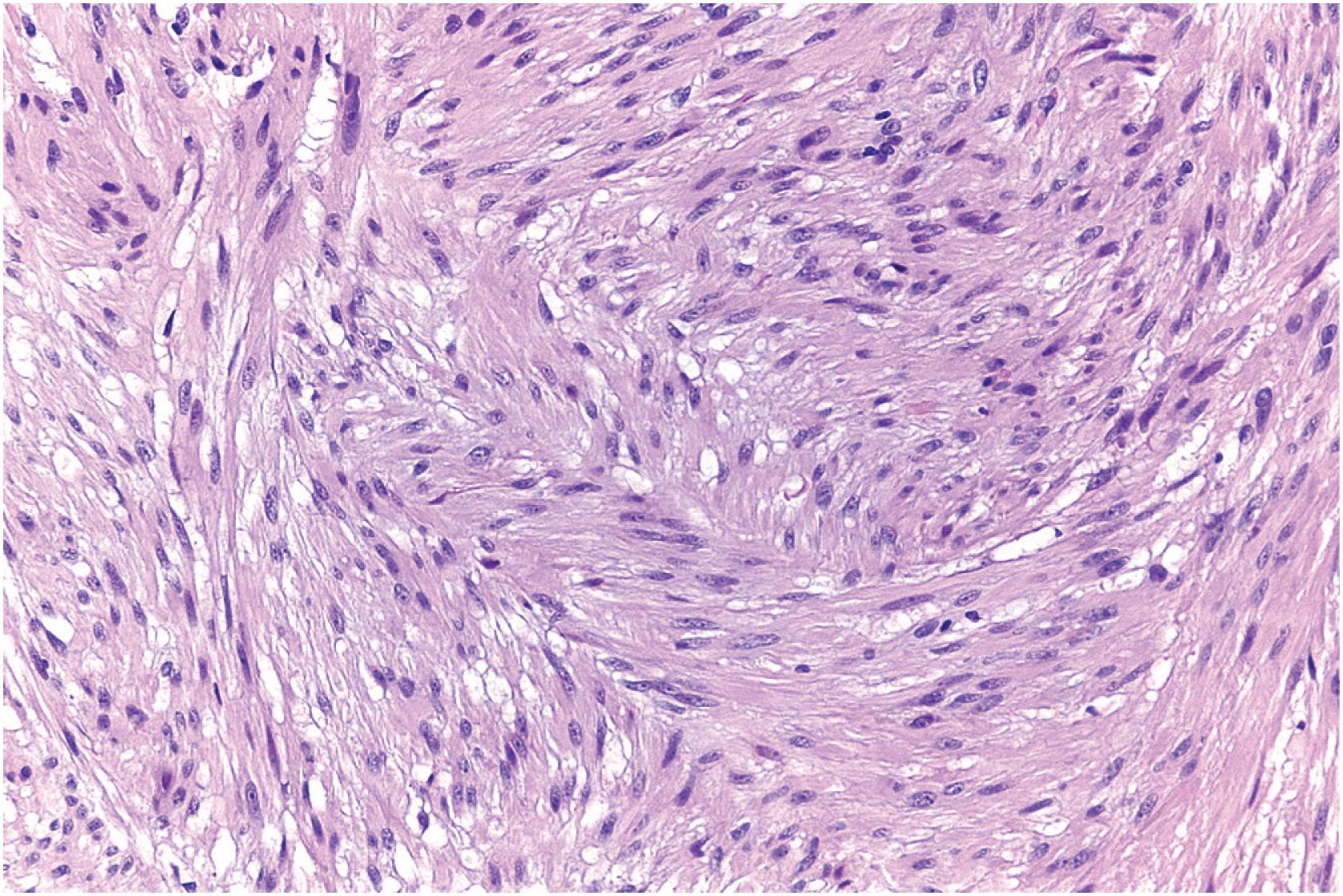
By immunohistochemistry, leiomyomas usually express the smooth muscle markers: smooth muscle actin, desmin, and h-caldesmon. While often diffuse, the expression may be patchy or focal. In addition, focal expression of keratin and S-100 protein are occasionally noted. In differentiating smooth muscle cells from myofibroblasts, h-caldesmon can be useful because it is not usually expressed by the latter.
The most important entity to be considered in the differential diagnosis of a benign smooth muscle is a more aggressive tumor with smooth muscle differentiation, including smooth muscle tumor of uncertain malignant potential and leiomyosarcoma. In general, the classification of smooth muscle tumors as benign or malignant involves evaluating cytologic atypia, the presence of necrosis, and mitotic index; the specific criteria vary by tumor site and are detailed below. Any significant cytologic atypia should prompt a careful search for mitotic figures and consideration of submission of additional sections.
Simple excision is adequate therapy for leiomyoma. Although these tumors may recur, they do not metastasize.
Pilar leiomyoma is a rare tumor that arises from the dermal arrector pili smooth muscles. Typically, they present clinically as clusters of red to brown papules or, more rarely, as a single nodule. They are frequently painful. When multiple, they most commonly affect adolescents to young adults, and when solitary, they usually develop in adulthood. The most common sites of involvement are the extensor surfaces of the extremities, followed by the trunk and head and neck. Multiple pilar leiomyomas are often associated with a germline mutation of the fumarate hydratase gene. Several studies have shown up to 85%–89% of patients with cutaneous leiomyomatosis demonstrate the fumarate hydratase gene mutation. This mutation predisposes patients to hereditary leiomyomatosis and renal cell carcinoma (HLRCC) syndrome, a condition associated with an increased incidence of early-onset uterine leiomyomas and renal cell carcinoma. 4,6,7
Pilar leiomyomas are poorly defined tumors, located in the subcutis, and are generally less than 2 cm in maximum dimension.
Unlike the orderly, intersecting fascicles of tumor cells seen in most well-differentiated smooth muscle tumors, pilar leiomyomas have a more disorganized architecture, similar to the normal arrangement of arrector pili smooth muscle cells ( Fig. 6.2 ). The tumor cells are brightly eosinophilic with blunt-ended, somewhat vesicular nuclei ( Fig. 6.2B ). Focal degenerative-type nuclear atypia may be seen. An infiltrative pattern may be present at the periphery. Rare mitoses may be present; cases of leiomyoma lacking necrosis with up to 1–2 per 10 high-power fields (HPF) have been reported. The morphologic appearance of scrotal leiomyomas (dartoic leiomyomas) is identical to that of pilar leiomyomas elsewhere.
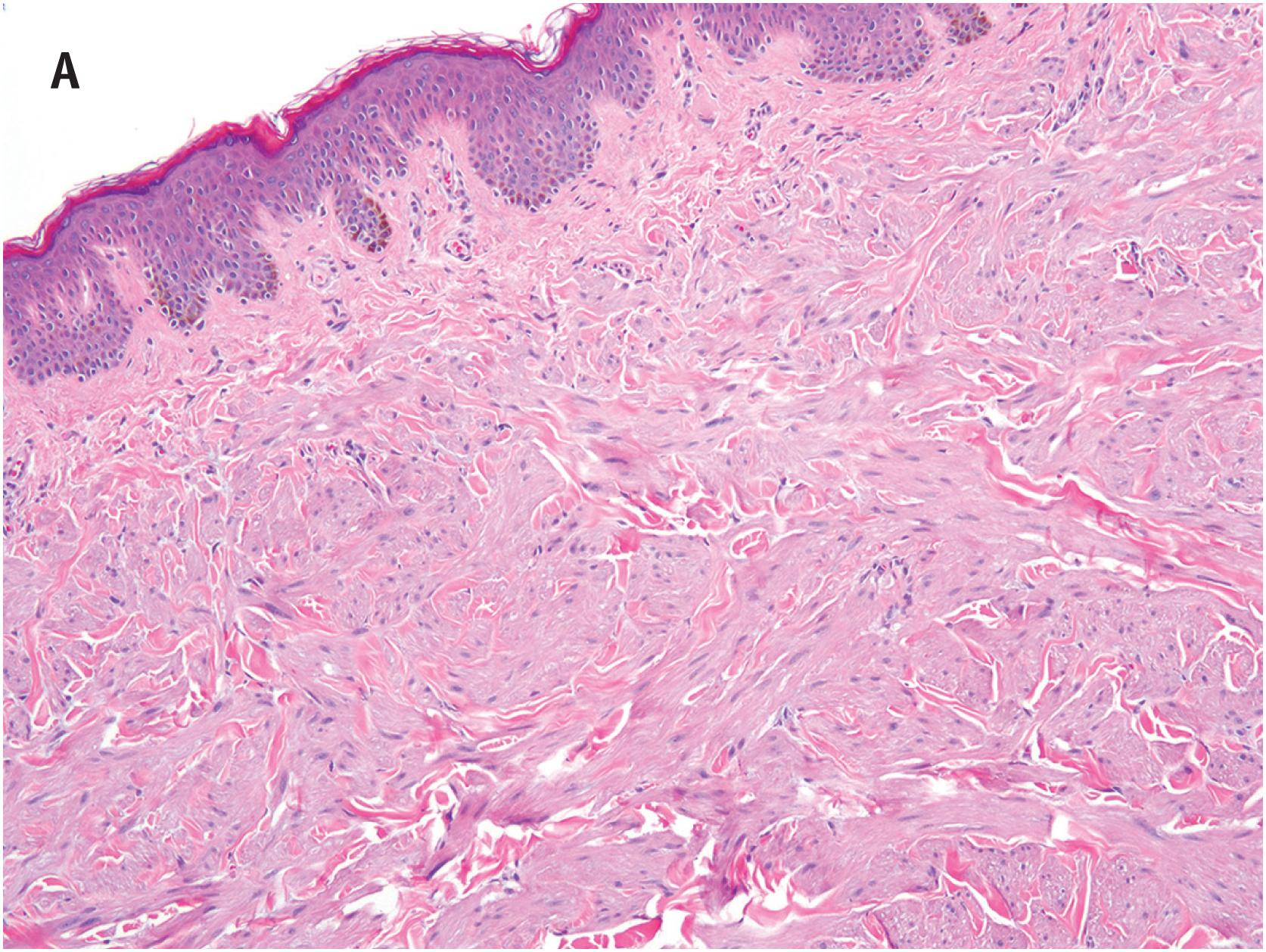
Benign mesenchymal tumor with smooth muscle differentiation that is classified according to location as pilar, retroperitoneal-abdominal cavity and somatic soft tissue.
Incidence and Location
Pilar: uncommon; extremities > trunk, hair-bearing skin
Somatic soft tissue: rare; extremities
Retroperitoneal-abdominal cavity: slightly more common; retroperitoneum, abdominal wall, omentum, mesentery
Pilar: when multiple, may be associated with hereditary leiomyomatosis and renal cell carcinoma (HLRCC) with increased risk for aggressive type 2 papillary renal cell carcinoma
Somatic soft tissue: none
Retroperitoneal-abdominal cavity: none
Pilar leiomyoma: adolescents to young adults when multiple, adults when solitary
Somatic soft tissue: equal sex distribution; primarily middle-aged adults
Retroperitoneal-abdominal cavity: much more frequent in females than males; perimenopausal
Pilar: multiple > single; often painful
Somatic soft tissue: enlarging mass
Retroperitoneal-abdominal cavity: pain; mass effect
Complete surgical excision is the appropriate treatment
Circumscribed (pilar often infiltrative), with a rubbery texture, whorled surface and white-to-grey coloring; hemorrhage, cystic change, myxoid stroma, and calcifications may be apparent
All types: smooth muscle morphology (intersecting fascicles, eosinophilic cytoplasm, blunt ended-nuclei) no significant (moderate-to-severe) cytologic atypia or necrosis.
Pilar: thickened, haphazardly arranged bundles of well differentiated smooth muscle cells; infiltrative to well circumscribed. No more than rare mitoses (<1 per 10 HPF)
Somatic soft tissue: <1 mitosis per 50 HPF
Retroperitoneal-abdominal cavity: <6 mitoses per 50 HPF (female), experience in males very limited and lower mitotic counts (<1 mitosis per 50 HPF) may be appropriate
Expression of desmin, smooth muscle actin, and/or h-caldesmon
Pilar: cutaneous leiomyosarcoma/atypical intradermal smooth muscle tumor
Retroperitoneal-abdominal cavity: cellular schwannoma, leiomyosarcoma, GIST, leiomyosarcoma
Somatic soft tissue: schwannoma, leiomyosarcoma
Smooth muscle actin, desmin, and h-caldesmon are usually strongly expressed.
Pilar leiomyomas must be distinguished from their malignant counterpart cutaneous leiomyosarcoma/atypical pilar smooth muscle tumors (see later). Strict criteria regarding the relationship between mitotic index and malignancy in cutaneous smooth muscle tumors have not been established; diagnosis requires synthesis of all of the clinical and pathologic data. Cutaneous leiomyosarcomas usually demonstrate increased cellularity, marked nuclear atypia, and an elevated mitotic index (with a mean of 10 mitoses per high-power field). Pilar leiomyoma demonstrates infiltrative borders but does not demonstrate extension into the subcutis, which may be seen in cutaneous leiomyosarcoma. Additionally, more than 50% of cases of pilar leiomyoma present as multiple lesions, whereas cutaneous leiomyosarcoma typically presents as a solitary lesion.
Solitary nodules are adequately treated by simple excision; however, in cases with multiple tumors, surgical excision may not be feasible. In the latter setting, tumors gradually progress with enlargement of existing lesions and development of new tumors. Pain may contribute significantly to morbidity in these patients. When cutaneous leiomyomatosis is associated with hereditary leiomyomatosis and renal cell carcinoma (HLRCC) syndrome, individuals are at increased risk for aggressive type 2 papillary renal cell carcinoma.
Leiomyomas of deep soft tissue are subclassified into two major groups: those arising in the retroperitoneum or abdominal cavity of predominantly female patients (retroperitoneal-abdominal cavity leiomyoma), and those arising in the deep subcutaneous or subfascial soft tissue of the extremities of either sex (leiomyoma of somatic soft tissue). Both forms are very rare, with retroperitoneal-abdominal cavity leiomyoma being the more common of the two.
Like uterine leiomyomas, leiomyomas of the retroperitoneum-abdominal cavity are believed to originate from hormone-sensitive smooth muscle. They occur predominantly in women, usually in the perimenopausal period. Because of their location, they may reach a significant size by the time of diagnosis.
Leiomyoma of somatic soft tissue most commonly arises in the extremities and predominantly affects middle-aged adults. They frequently contain calcifications which may be detected radiographically.
Retroperitoneal-abdominal cavity leiomyomas are often large, with a mean size of 14 cm. They tend to be circumscribed, lobulated masses that are similar in appearance to uterine leiomyoma, with a firm, whorled, grey-to-white, and often trabeculated cut surfaces.
Leiomyomas of somatic soft tissue are well demarcated, fusiform-to-spherical, white-to-gray tumors ranging in size from 0.6 to 12.5 cm. If significant myxoid areas are present, the tumor may appear gelatinous.
Retroperitoneal-abdominal cavity tumors bear a strong resemblance to uterine leiomyoma by morphology and immunoprofile. The tumors are composed of well-differentiated smooth muscle cells arranged in a cord-like or reticular pattern. ( Fig. 6.3 ). Cytologic atypia is minimal, although degenerative changes may be seen as in uterine leiomyomas. Of note, in female patients, a slightly higher mitotic index is permitted (1–5 mitoses per 50 HPF). There are only rare reported cases of retroperitoneal leiomyoma in males. Thus, in males, it may be better to take a more cautious approach and to accept only up to 1 mitoses per 50 HPF for leiomyoma and to diagnose as a “smooth muscle tumor of uncertain malignant potential” tumors with 2–5 mitoses per 50 HPF.
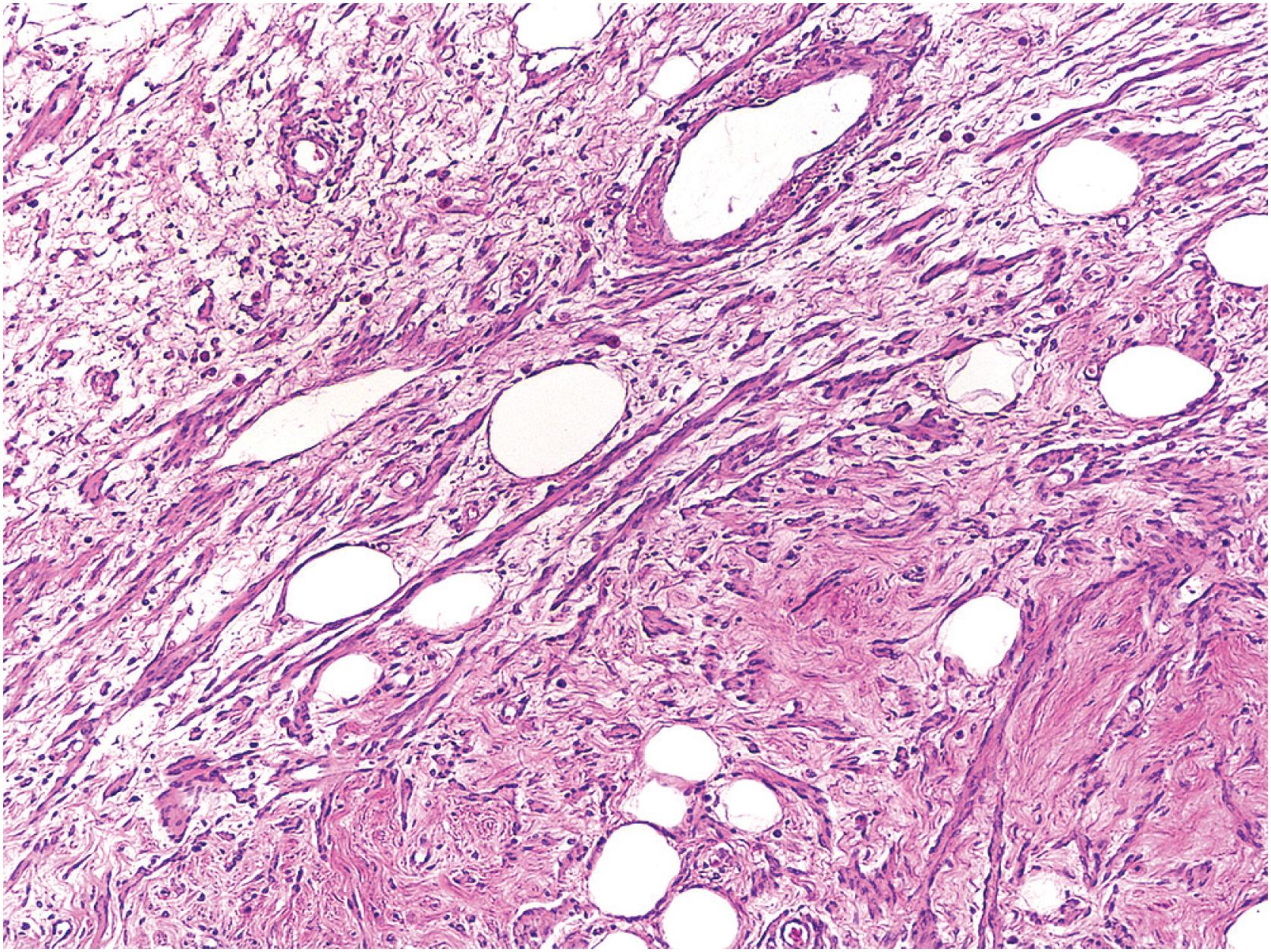
Leiomyomas of somatic soft tissue show typical smooth muscle features, including intersecting fascicles of spindle cells with eosinophilic cytoplasm, and blunt-ended, cigar-shaped nuclei. Myxoid change and hyalinization are commonly seen, as are calcifications ( Figs 6.4 and 6.5 ). Necrosis and significant cytologic atypia are not seen. In contrast to retroperitoneal-abdominal cavity leiomyomas, leiomyomas of somatic soft tissue should show almost no mitoses. Some authors propose a cut-off of less than 1 mitosis per 50 HPF to diagnose a leiomyoma of somatic soft tissue.
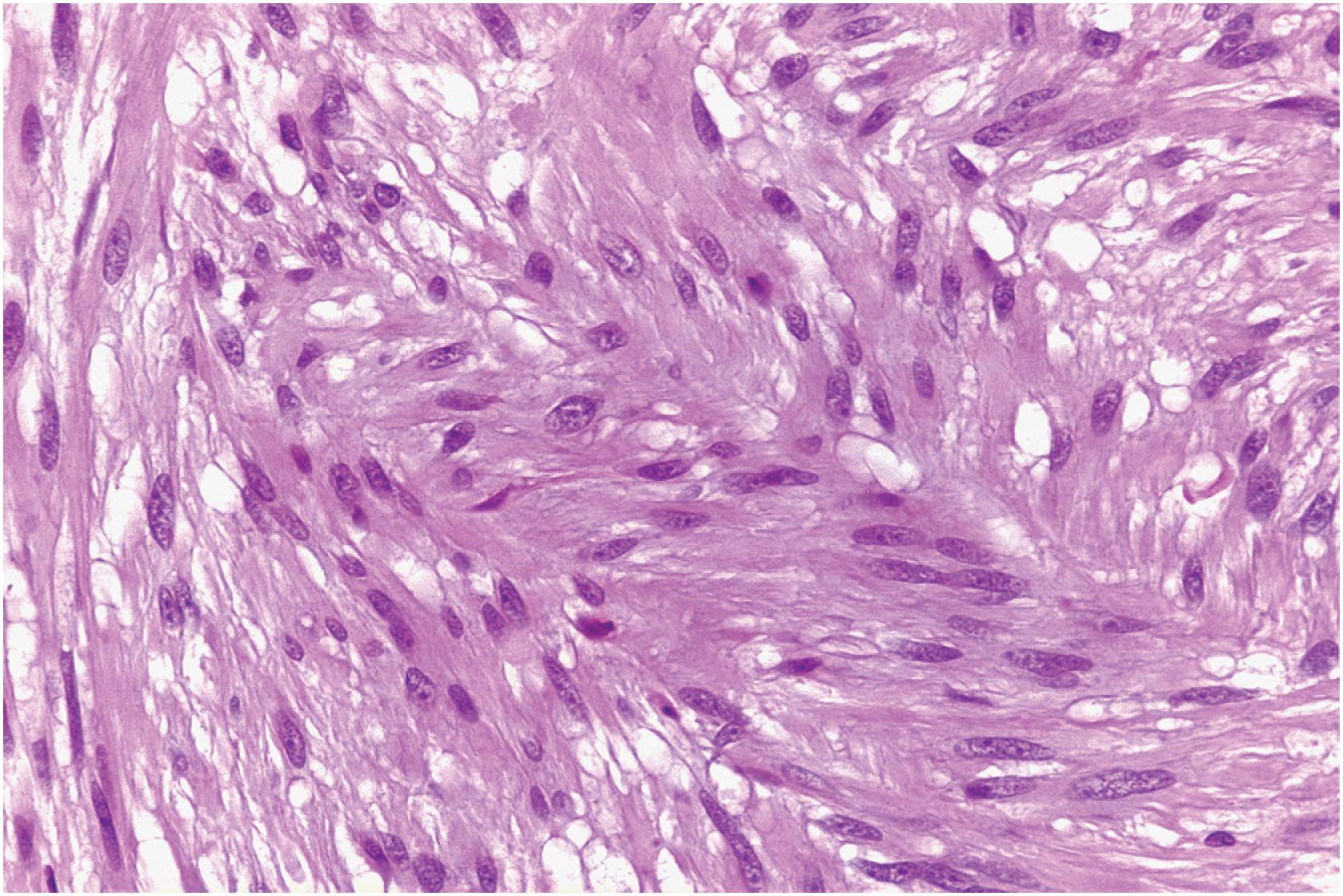
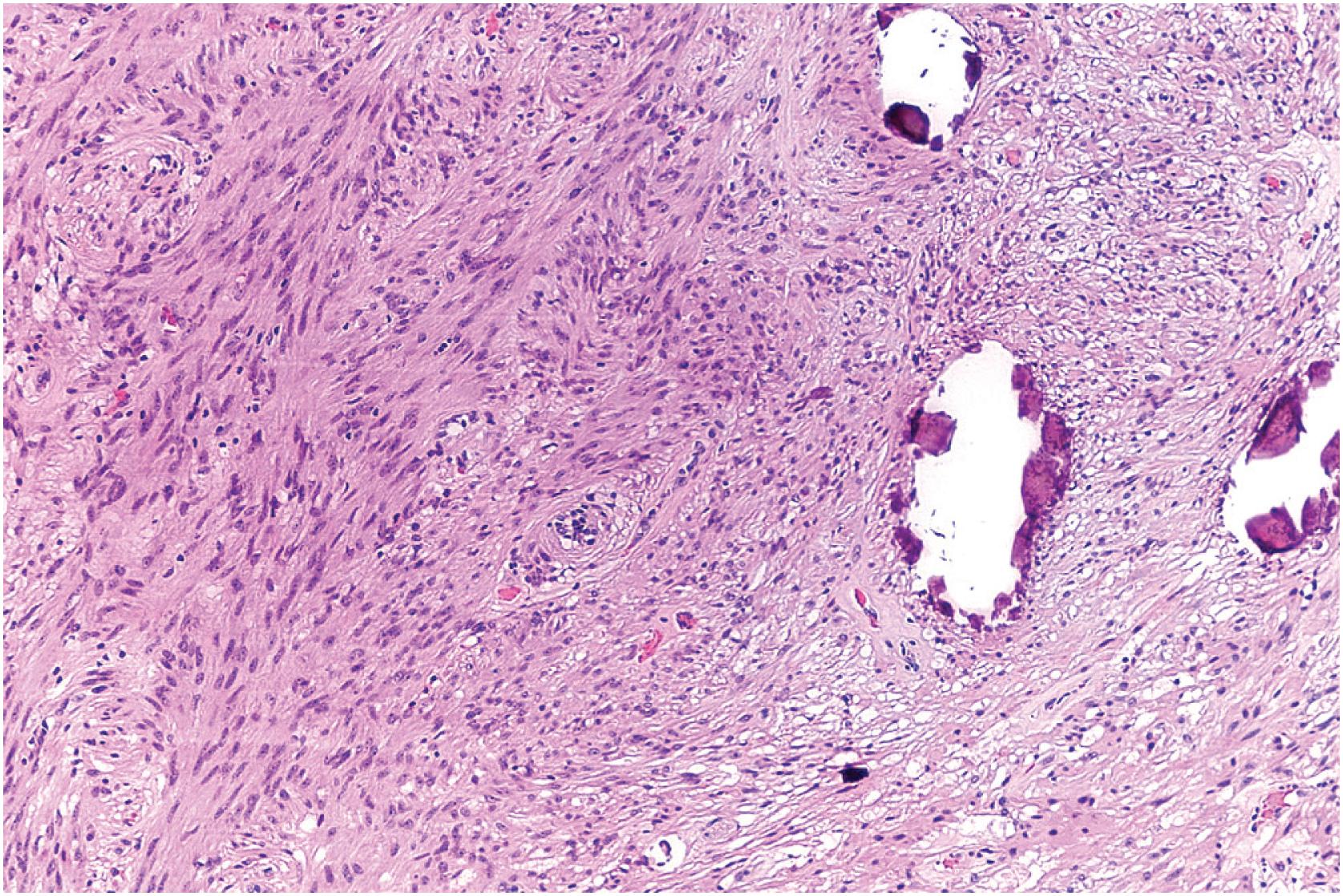
In either the retroperitoneum or somatic soft tissue, the findings of necrosis, cytologic atypia, or more than 1 mitosis per 50 HPF, should prompt careful histologic examination and possibly submission of additional sections to exclude the possibility of a leiomyosarcoma (see below). A diagnosis of smooth muscle tumor of uncertain malignant potential should be made when no atypia or necrosis is seen, but a low level of mitotic activity is present (>1 mitosis per 50 HPF in somatic soft tissue or the retroperitoneum of males and >5 mitoses per 50 HPF in the retroperitoneum of females) ( Fig. 6.6 ).
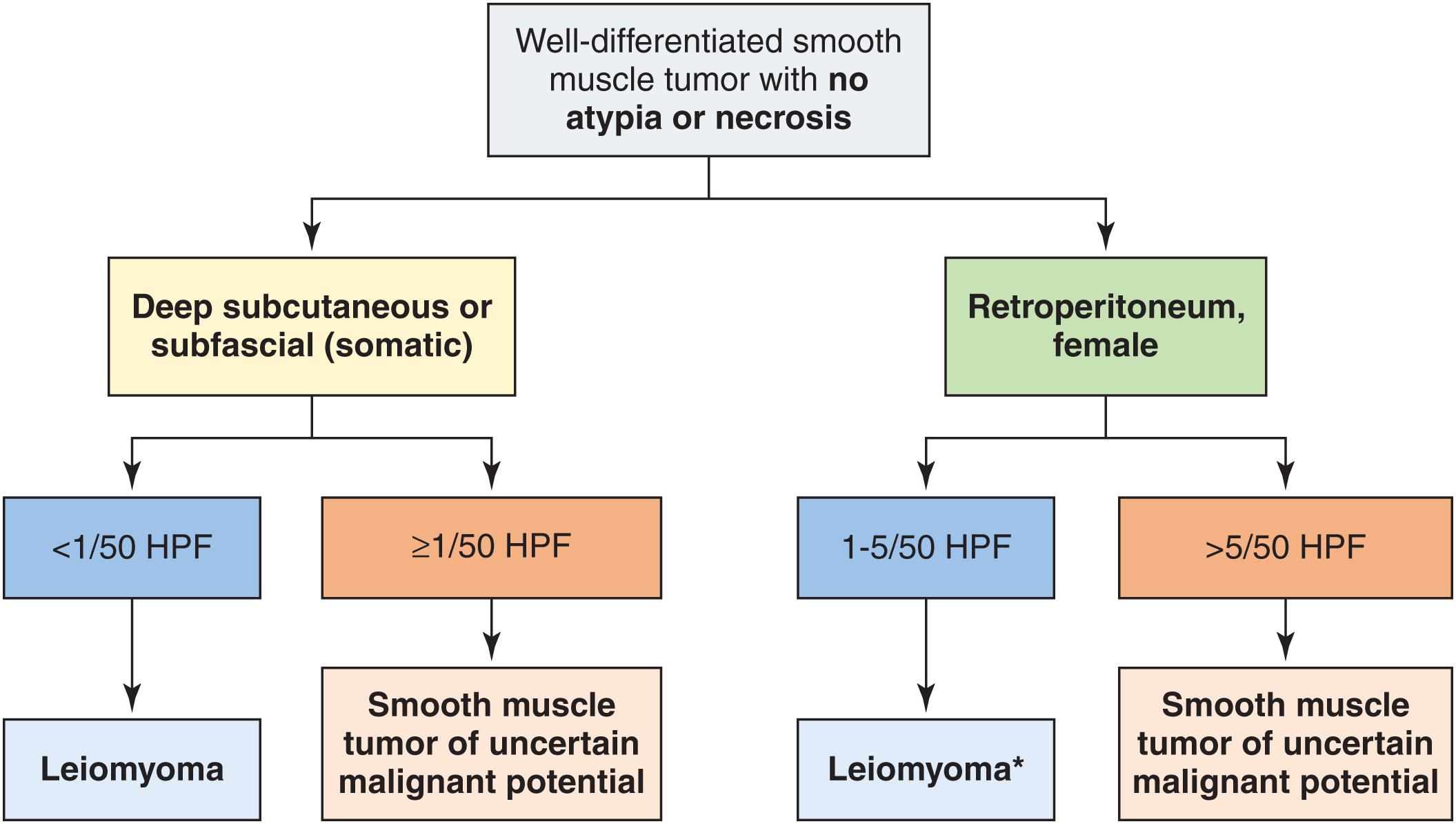
Smooth muscle actin, desmin, and h-caldesmon are at least focally expressed in leiomyomas of deep soft tissue. Unlike leiomyomas in other sites, retroperitoneal-abdominal cavity leiomyomas commonly express estrogen and progesterone receptors, in addition to smooth muscle-specific antigens.
The primary consideration in the differential diagnosis of retroperitoneal-abdominal cavity or somatic soft tissue leiomyomas is smooth muscle tumor of uncertain malignant potential and leiomyosarcoma. The distinction between these entities is discussed above.
In the retroperitoneum-abdominal cavity, the differential diagnosis also includes gastrointestinal stromal tumor (GIST) and cellular schwannoma. GIST is typically more cellular than leiomyomas, may have epithelioid areas, and is positive for CD117 and/or DOG1, often CD34 positive, focally SMA positive, and rarely desmin positive. In both somatic soft tissues and the retroperitoneum- abdominal cavity, cellular schwannomas may enter the differential, particularly as they are diffusely cellular and lack the hypo- and hypercellular areas (“Antoni A and Antoni B”) seen in typical schwannomas. Cellular schwannomas are cellular spindled cell proliferations, and careful microscopic examination usually discloses lipid-laden histiocytes and hyalinized blood vessels. Furthermore, like typical schwannomas, cellular schwannomas are strongly and diffusely positive for S-100 protein and SOX10 and negative for muscle markers. Leiomyomas with nuclear palisading can suggest a diagnosis of schwannoma; the latter lesion, however, is usually encapsulated and like all schwannomas is diffusely S-100 protein-positive.
Simple excision for leiomyoma of the retroperitoneum-abdominal cavity and somatic soft tissues is curative. They do not have metastatic potential, but local recurrences in retroperitoneal-abdominal cavity leiomyomas have been reported.
Vascular leiomyomas occur in a wide age range, with an increased incidence in patients between the fourth and sixth decades of life. Most cases present as solitary nodules that are superficially located in the subcutis or, rarely, the deep dermis. The extremities, particularly the lower leg, are the most common sites. Pain is a common symptom. The solid subtype of vascular leiomyoma has a marked female predominance, is usually located on the extremities, and is often painful. In contradistinction, the venous subtype shows a slight predilection for male individuals, is often located on the head, and is rarely painful.
Vascular leiomyomas are well-circumscribed, white-to-gray nodules, generally less than 2 cm in maximum dimension. Calcifications can sometimes be appreciated macroscopically.
Three histologic subtypes of vascular leiomyoma have been identified: solid, venous, and cavernous. All subtypes are composed of proliferating, well-differentiated smooth muscle cells and vessels. Calcification, myxoid change, and hyalinization are common findings, but degenerative atypia is rarely seen. Criteria for “symplastic” leiomyoma (leiomyoma with degenerative nuclear atypia) of somatic soft tissue have not been elaborated, and any nuclear atypia should raise suspicion for malignancy. The solid subtype is the most common and is characterized by intersecting fascicles of bland spindled cells with a well-developed, thin-walled vasculature. In contrast, the vessels in venous vascular leiomyomas are thick walled, and the constituent smooth muscle cells merge with surrounding muscle bundles ( Fig. 6.7 ). Cavernous vascular leiomyoma displays a similar merging of vessel wall and smooth muscle; however, the vessels in this tumor are thin-walled and dilated, as the name implies.
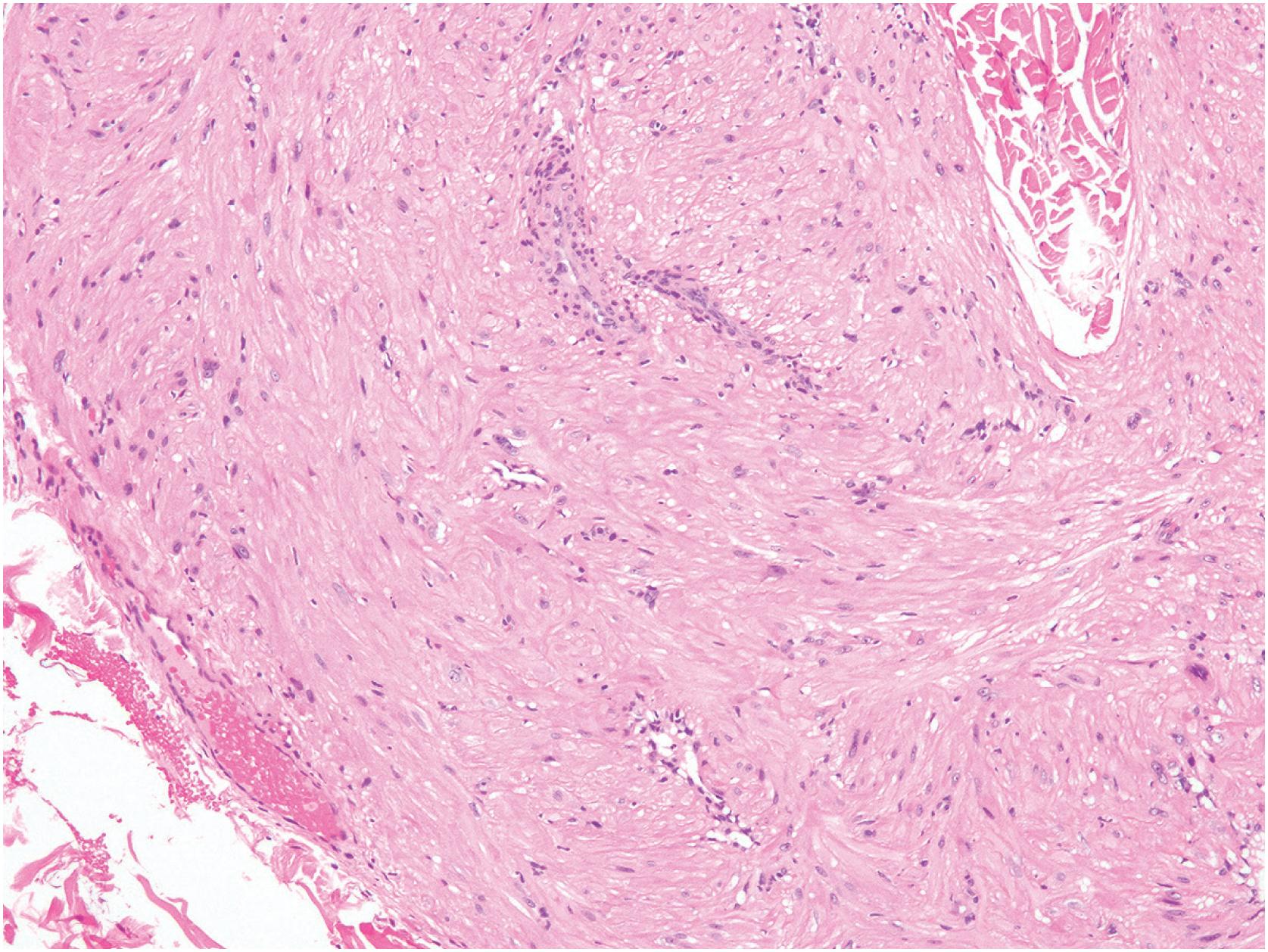
Become a Clinical Tree membership for Full access and enjoy Unlimited articles
If you are a member. Log in here